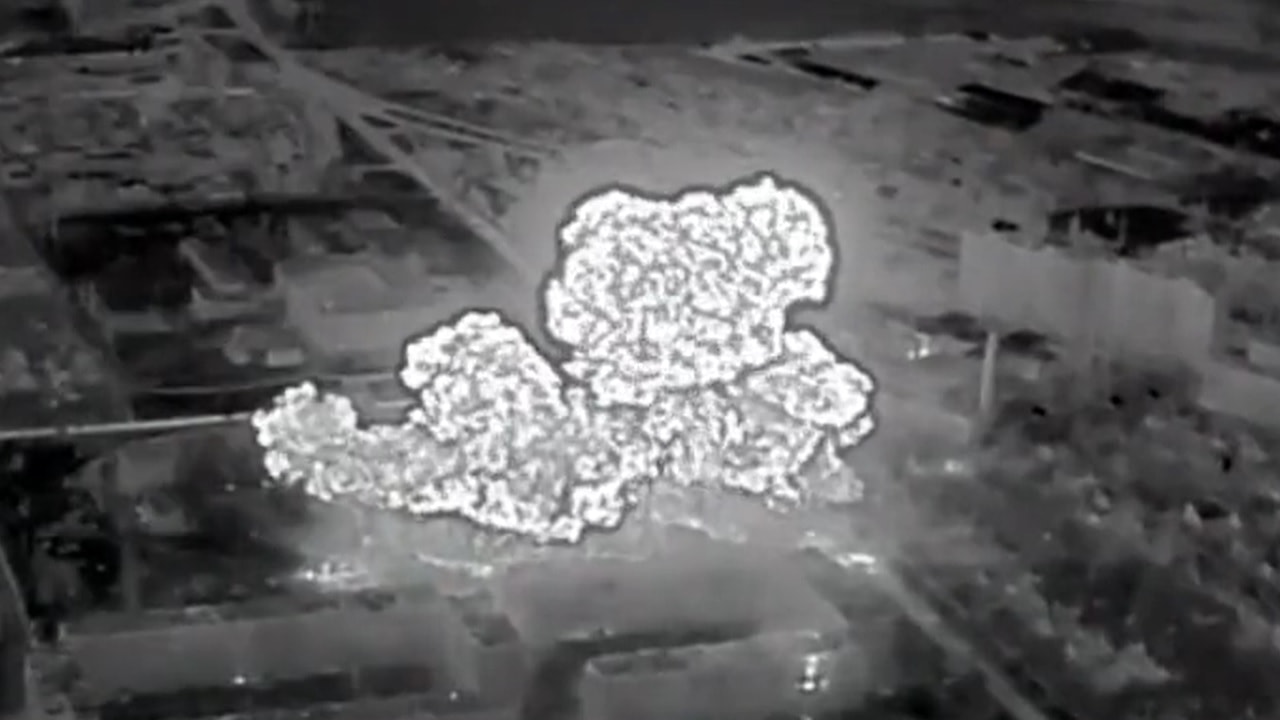On Tuesday morning, a new video showing the deployment of a mine-clearing land charge near Bakhmut was shared on social media. It provided a thermal view of a UR-77 or a U.S. equivalent being used in an occupied part of the urban center.
In the nearly 50-second video that was filmed by a drone, a rocket is seen being launched over a section of the city believed to be under the control of the Wagner Group, the Russian private military contractors supporting the Kremlin’s forces. A massive explosion is then set off near a block of apartment buildings likely occupied by Wagner.
A mine clearing land charge (MCLC or MICLIC) is essentially a rocket-assisted rope of explosives that can be fired over a minefield to clear a path. It is known in the U.S. military as a “mick lick.”
Soviet-era Meteorit in the Spotlight
It is unclear what launched the charge, but according to reports on social media, it was likely fired by a UR-77 Meteorit, a Soviet-era mine-clearing vehicle that is based on a variant of the 2S1 Gvozdika chassis. Introduced in the late 1970s, the tracked vehicle is armed with a launcher and two mine clearing line charges.
The vehicle has a crew of two, including a driver and operator. It is powered by a 300 horsepower, V8 diesel engine that provides a maximum road speed of 60 km/h. Although intended to operate near minefields, the UR-77 does not feature any protection against mines.
As noted, the mine clearing land charge consists of a rocket-assisted line that can be fired over a minefield. When detonated, the charge causes a shock wave that is able to destroy or disable all the shells or mines — even those that are buried — in an area along the charge with a width of approximately 6 meters and a length of up to 90 meters.
However, the platform is also used offensively: Its line charge can destroy an entire street in urban combat. Russian forces deployed the UR-77 in such a role in Syria, and Ukrainian troops are now copying the Russian tactic with vehicles captured in recent fighting. Around two dozen of the UR-77s are now being employed by Kyiv’s forces.
Enemy Mine
In addition to the UR-77s, the Ukrainian military has been equipped with a number of the U.S.-made M58 MICLIC, a platform that entered service in 1988. It provides an 8 meter-by-100-meter lane. Some of these vehicles were sent to Ukraine as part of last September’s security assistant package from the U.S. Department of Defense to counter Russian deployment of anti-personnel and anti-vehicle mines.
As previously reported, the New York-based Human Rights Watch warned in June that Russia was using landmines and other ordnance “that are causing civilian casualties and suffering, as well as disrupting food production.” Among the mines being used by the Kremlin’s forces are POM-2 and POM-3 mines that are reportedly dropped indiscriminately by aircraft or fired from specialized ground launchers. As Wired also reported, these are not buried but rather are scattered across large swaths of land. There is no reliable way to remotely track or disarm the mines.
Thermal view of a UR-77 Meteorit or US equivalent (MICLIC) being used on a Wagner occupied area of Bakhmut.
What’s being used is a Mine Clearing Line Charge (MCLC or MICLIC), which is basically a rocket-assisted ‘rope’ of explosives fired over a minefield to clear a path. pic.twitter.com/dfON15GXRP
— Seveer of the 95th rifles ???????????????? (@Seveerity) April 4, 2023
The POM-3 was never employed in combat until Russia used it in Ukraine. It was designed with a seismic sensor that triggers the mine when disturbed by footsteps. Once tripped, it jettisons an explosive payload to roughly head height before detonating.
MICLIC systems are now being used to help clear the land. It also appears, based on the recent videos, that Ukraine may be using the systems in an offensive capability to clear houses of enemy invaders.
Author Experience and Expertise
A Senior Editor for 19FortyFive, Peter Suciu is a Michigan-based writer. He has contributed to more than four dozen magazines, newspapers, and websites with over 3,200 published pieces over a twenty-year career in journalism. He regularly writes about military hardware, firearms history, cybersecurity, politics, and international affairs. Peter is also a Contributing Writer for Forbes and Clearance Jobs. You can follow him on Twitter: @PeterSuciu.

